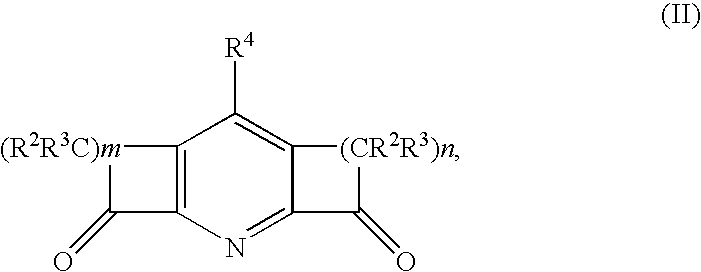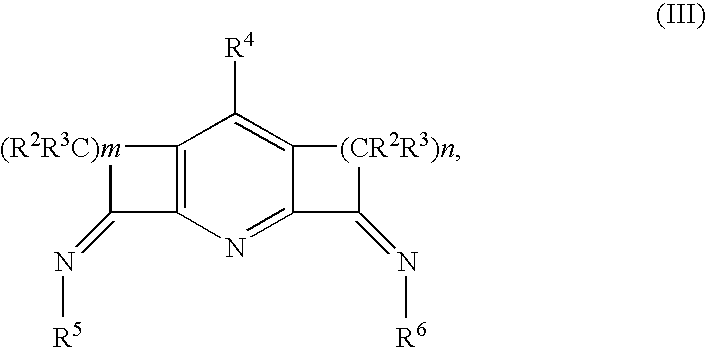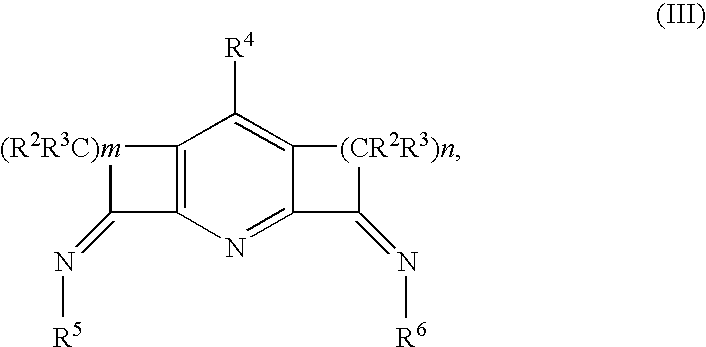Catalysts for olefin polymerization or oligomerization
a technology of oligomerization and catalysts, applied in the direction of organic-compound/hydride/coordination-complex catalysts, physical/chemical process catalysts, iron organic compounds, etc., can solve the problems of difficult or impossible to obtain
- Summary
- Abstract
- Description
- Claims
- Application Information
AI Technical Summary
Benefits of technology
Problems solved by technology
Method used
Image
Examples
example 1
4,5-Bis-2′-methylphenylimino-1,2,3,4,5,6,7,8-octahydro-acridine (1)
[0149]
[0150]2,3,7,8-Tetrahydro-1H,6H-acridine-4,5-dione (0.5 g, 2.32 mmol), 0.55 g (5.13 mmol) of o-tolylamine, a few crystals of p-toluenesulfonic acid and 8 ml of ethanol were refluxed for 8 h under argon with stirring. Upon cooling the reaction mixture to ambient temperature, a red precipitate formed. It was filtered off and washed with 10 ml of cold ethanol and dried under 133 Pa (absolute) pressure for 12 h. Yield of (1) was 0.62 g (68%) with an mp of 256° C. 13C-NMR (CD2Cl2) (selected signals): 161.58 ppm (acyclic C═N). Elemental analysis calculated for C27H27N3: C, 82.41; H, 6.92; N, 10.68. Found: C, 82.19; H, 6.72; N, 10.50. GC / LS exact mass calculated for C27H27N3: 393.22; found: 393.22.
example 2
4,5-Bis-2′-methylphenylimino-1,2,3,4,5,6,7,8-octahydro-acridine iron(II) chloride (1a)
[0151]
[0152](1) (3.12 g, 7.9 mmol), 1.00 g (7.9 mmol) of iron(II) chloride and 100 ml of n-butanol were heated for 30 min at 80° C. A dark precipitate formed and was filtered and washed twice with 40 ml of ethyl ether and dried under 133 Pa (absolute) pressure for 12 h. Yield of (1a) was 2.81 g (68%) as a black powder. Exact mass direct probe calculated for C27H27Cl2FeN3 was 519.09. Found exact mass with isotopic pattern: m / e: 519.09 (100.0%), 521.09 (62.7%), 520.10 (29.3%), 522.09 (20.8%), 523.09 (10.7%), 517.09 (6.2%), 521.10 (5.1%), 520.09 (4.5%), 524.09 (3.3%), 523.10 (2.8%), 518.10 (1.9%). Elemental analysis calculated for C27H27Cl2FeN3: C, 62.33; H, 5.23; N, 8.08. Found: C, 62.42; H, 4.86; N, 7.82.
experiment 1
4-tert-Butylphenyl Boronic Acid
[0153]A solution of para-tert-butylphenyl magnesium bromide prepared from 52 ml of para-tert-butylphenyl bromide and 8.0 g of the magnesium turnings in 250 ml of diethyl ether was added to 81 ml of tri-n-butyl borate in 250 ml of diethyl ether at −80° C. with stirring under argon. The reaction mixture was allowed to warm to ambient temperature, and was poured into 150 ml of 10% sulfuric acid in water. The organic phase was extracted twice by 100 ml of diethyl ether. The solvent and n-butanol were removed under vacuum. The viscous residue was recrystallized from boiling water. Yield of 4-tert-butylphenyl boronic acid was 10% as white crystals with mp. 202-203° C.
PUM
| Property | Measurement | Unit |
|---|---|---|
| weight percent | aaaaa | aaaaa |
| weight percent | aaaaa | aaaaa |
| weight percent | aaaaa | aaaaa |
Abstract
Description
Claims
Application Information
 Login to View More
Login to View More - R&D
- Intellectual Property
- Life Sciences
- Materials
- Tech Scout
- Unparalleled Data Quality
- Higher Quality Content
- 60% Fewer Hallucinations
Browse by: Latest US Patents, China's latest patents, Technical Efficacy Thesaurus, Application Domain, Technology Topic, Popular Technical Reports.
© 2025 PatSnap. All rights reserved.Legal|Privacy policy|Modern Slavery Act Transparency Statement|Sitemap|About US| Contact US: help@patsnap.com



